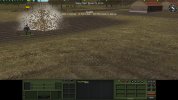I am not sure about shell walls. I do know that both shells have a diameter of 75mm. I also know that the US projectile is LONGER and thus heavier and deadlier to infantry. CMX1 gave the Sherman 75mm a blast value of 52 vs 45 for the Panther 75mm, IIRC.Because it is fired at a higher velocity the shell 'walls' needs to be stronger and thus has less grams of explosive inside, at least that's how I understand it.
But the German shell (which combines the case and the projectile) is bigger. The Germans used a lot of powder to drive a smaller shell really fast.
Well known doctrinal differences clear drive different weapons, shells and projectiles.






















